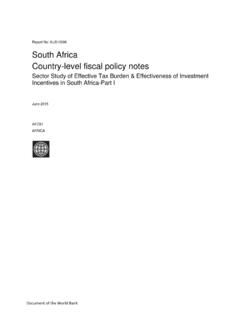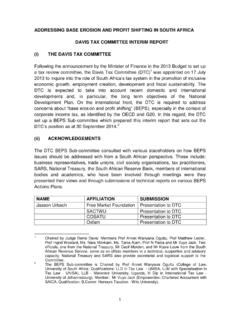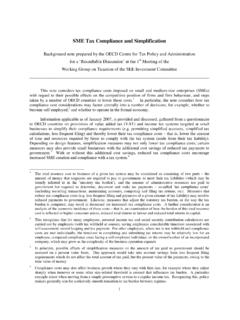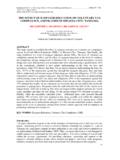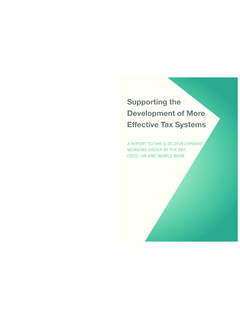Transcription of SMALL AND MEDIUM ENTERPRISES - Tax Com
1 FIRST INTERIM REPORT ON SMALL AND MEDIUM ENTERPRISES FOR THE MINISTER OF FINANCE Intended use of this document: The Davis Tax Committee is advisory in nature and makes recommendations to the Minister of Finance. The Minister will take into account the report and recommendations and will make any appropriate announcements as part of the normal budget and legislative processes. As with all tax policy proposals, these proposals will be subject to the normal consultative processes and Parliamentary oversight once announced by the Minister. THE DAVIS TAX COMMITTEE January 2014 CONTENTS LIST OF ABBREVIATIONS .. 4 CHAPTER 1 - INTRODUCTION .. 5 THE ROLE OF SMALL AND MEDIUM ENTERPRISES IN THE ECONOMY .. 5 DETERMINING WHAT A SMALL AND MEDIUM enterprise IS .. 5 ISSUES ARISING FROM THE APPLICABLE DEFINITIONS .. 8 THE LIMITATIONS OF RELYING ON THE SMALL AND MEDIUM ENTERPRISES SECTOR AS A REVENUE CONTRIBUTOR .. 12 CHALLENGES OF PAST INITIATIVES TO ENSURE REVENUE CONTRIBUTIONS BY SMEs.
2 13 CHAPTER 2 - INCOME TAX PROVISIONS FOR SMEs .. 15 SECTION 12E: DEDUCTIONS FOR SMALL BUSINESS CORPORATIONS .. 15 SECTION 12J: THE VENTURE CAPITAL COMPANY SYSTEM .. 22 OTHER INCOME TAX PROVISIONS RELEVANT TO SMEs .. 25 CHAPTER 3 - MICRO BUSINESS TURNOVER TAX .. 26 THE WORKING OF MICRO BUSINESS TURNOVER TAX .. 26 EVALUATION OF THE EFFECTIVENESS OF THE MICRO BUSINESS TURNOVER TAX SYSTEM .. 26 RECOMMENDATIONS .. 28 CHAPTER 4 - VALUE-ADDED TAX AND SMALL BUSINESSES .. 32 CONCERNS REGARDING THE BASIC VALUE-ADDED TAX VOLUNTARY REGISTRATION THRESHOLD .. 33 CONCERNS REGARDING THE BASIS OF VAT REPORTING .. 34 CONCERNS REGARDING VAT PERIODS .. 35 CONCERNS REGARDING VAT REFUNDS .. 35 CHAPTER 5 - OTHER INCENTIVES RELEVANT TO THE SME SECTOR .. 37 THE EMPLOYMENT TAX INCENTIVE ACT .. 37 INCENTIVES PROVIDED BY THE DEPARTMENT OF TRADE AND INDUSTRY .. 41 DTC: SME s: July 2014 3 CHAPTER 6 - GENERAL COMPLIANCE CHALLENGES FOR SMEs.
3 44 A STUDY ON COMPLIANCE CHALLENGES FOR SMALL BUSINESSES .. 44 EVALUATION .. 46 RECOMMENDATIONS .. 47 APPENDIX 1 SUMMARY OF PRELIMINARY SMALL BUSINESS PROPOSALS .. 49 APPENDIX 2 LIST OF PARTIES CONSULTED BY DTC SMALL BUSINESS SUB-COMMITTEE .. 50 DTC: SME s: July 2014 4 LIST OF ABBREVIATIONS CGT: CAPITAL GAINS TAX DTC: DAVIS TAX COMMITTEE DTI: DEPARTMENT OF TRADE AND INDUSTRY ETI: EMPLOYMENT TAX INCENTIVE FSB FINANCIAL SERVICES BOARD FTA: FORUM ON TAX ADMINISTRATION INCOME TAX ACT: INCOME TAX ACT, 1962 (ACT NO. 58 OF 1962) MSB MINISTRY OF SMALL BUSINESS DEVELOPMENT NT NATIONAL TREASURY NDP: NATIONAL DEVELOPMENT PLAN PAYE: PAY-AS-YOU-EARN RCR: REFUNDABLE COMPLIANCE REBATE SARS: SOUTH AFRICAN REVENUE SERVICE SBC: SMALL BUSINESS CORPORATION SME: SMALL AND MEDIUM ENTERPRISES TAA: TAX ADMINISTRATION ACT, 2011 (ACT NO. 28 OF 2011) VAT ACT: VALUE-ADDED TAX, 1991 (ACT NO. 89 OF 1991) VCC: VENTURE CAPITAL COMPANY DTC: SME s: July 2014 5 CHAPTER 1 INTRODUCTION THE ROLE OF SMALL AND MEDIUM ENTERPRISES IN THE ECONOMY South Africa s National Development Plan (NDP) states that: SMALL and expanding firms will become more prominent, and generate the majority of new jobs created.
4 They will also contribute to changing apartheid legacy patterns of business ownership. They will be stimulated through public and private procurement, improved access to debt and equity finance, and a simplified regulatory The role of SMALL and MEDIUM -size ENTERPRISES (SMEs) has been accepted by the NDP as representing a critical sector for the promotion of employment, particularly in labour-absorbing industries. The NDP suggests that: A large percentage of the jobs will be created in domestic-orientated activities and in the services sector. Some 90% of jobs will be created in SMALL and expanding firms. The economy will be more enabling of business entry and expansion, with an eye to credit and market access. By 2030, this share of SMALL and MEDIUM -sized firms in output will grow substantially. Regulatory reform and support will boost mass entrepreneurship. Export growth, with appropriate linkages to the domestic economy, will play a major role in boosting growth and employment, with SMALL - and MEDIUM -sized firms being the main employment Given that government has accepted the parameters of the NDP, it stands to reason that the Davis Tax Committee (DTC) seeks to prioritise the examination of the tax system and its impact upon the promotion of SMALL and MEDIUM size businesses including an analysis of tax compliance costs, a possible streamlining of tax administration, the simplification of tax legislation and the role of incentives.
5 DETERMINING WHAT A SMALL AND MEDIUM enterprise IS At the outset of this investigation it is necessary to specify a categorisation of SMALL and MEDIUM -size businesses. There is currently no universally accepted definition of such firms in South Africa. For instance, the NDP, the National SMALL Business Act, 1996 1 South Africa: National Planning Commission National Development Plan: Vision for 2030 (11 November 2011) at 144. 2 South Africa: National Planning Commission National Development Plan at 119. DTC: SME s: July 2014 6 (Act No. 102 of 1996) as amended and the Income Tax, 1962 (Act No. 58 of 1962) as amended, each contain their own interpretations and It follows that the lack of a uniform definition for SMALL and MEDIUM -size businesses presented the DTC with considerable difficulty. Definitions in the NDP The NDP identifies three categories of business within the SME sector, defining them as: survivalist, lifestyle and entrepreneur.
6 Survivalist businesses: Briefly, the NDP appears to regard a survivalist business as essentially a home-based business or one which operates on the streets. Typically, entities of this nature display a manifest lack of the use of any capital equipment and predominantly take the form of cash businesses which do not compile more than the most basic of financial records. These include taxi operators, spaza shops, taverns, casual construction workers, hawkers, informal subcontractors and gardeners. Lifestyle businesses: The NDP defines a lifestyle business as one based at home (often in middle- and upper-class areas) or a business which has a single office. An example of this kind of business would include a doctor, electrician, plumber, artisan, engineer, accountant, franchisee, broker, consultant and a SMALL production assembly as well as a technology provider.
7 Entrepreneurial businesses: These types of businesses are defined in the NDP as concerned with expansion of business by an entrepreneur who wants to develop a brand, expand its market share or even develop a franchise. Entrepreneurs may invent a new process, a new product, or even a new market. It is these types of businesses in which venture capitalists may show an interest as regards investing. It is this category of business which the NDP considers will be most successful in the generation of employment. Definition in the National SMALL Business Act, 1996 The National SMALL Business Act, 1996, defines a SMALL enterprisebusiness as follows: ..A SMALL business means a separate and distinct business entity, including cooperative ENTERPRISES and non-governmental organisations, managed by one owner or more which, including its branches or subsidiaries, if any, is predominantly carried on in any sector or subsector of the economy mentioned in column I of the Schedule 3 Other statutes that are relevant to this matter are: The Broad-Based Black Economic Empowerment (BBBEE) Act 53 of 2003, read with the BBBEE Codes of Good Practice, and the Employment Equity Act 55 of 1998 read with its Codes of Good Practice.
8 Comment [F1]: Page no. or at least section no. ref required too, as there is no footnote ref to them . Vinesh to provide Formatted: Font: (Default) Arial,11 ptFormatted: Normal, Don't adjustspace between Latin and Asiantext, Don't adjust space betweenAsian text and numbersFormatted: Font: (Default) Arial,11 pt, English (South Africa)Formatted: Font: (Default) Arial,11 pt, English (South Africa)Formatted: Font: (Default) Arial,11 pt, English (South Africa)Formatted: Font: (Default) Arial,11 pt, English (South Africa)DTC: SME s: July 2014 7 and which can be classified as a micro-, a very SMALL , a SMALL or a MEDIUM enterprise by satisfying the criteria mentioned in columns 3, 4 and 5 of the Schedule opposite the smallest relevant size or class as mentioned in column 2 of the Schedule ;a separate and distinct business entity, together with its branches or subsidiaries, if any, including co-operative ENTERPRISES , managed by one owner or more predominantly carried on in any sector or subsector of the economy mentioned in column 1 of the Schedule and classified as a micro-, a very SMALL , a SMALL or a MEDIUM enterprise by satisfying the criteria mentioned in columns 3, 4 and 5 of the Schedule.
9 The relevance of the Schedule for the purposes of this analysis is that in all the sectors or sub-sectors of the economy mentioned in the Schedule, the key criteria for determining whether the enterprise can be classified as MEDIUM , SMALL , very SMALL or micro turn on the total full-time equivalent of paid employees, the total turnover and the total gross asset value. Save in the case of agriculture, a MEDIUM -size business is defined as a business which has a total full-time paid employee complement of 200 or more employees. A SMALL business is considered to have 50 employees, a very SMALL business 20 employees and a micro business, 5 employees. The total turnover for a MEDIUM -size business ranges from a minimum of R5 million in the case of agriculture to R64 million in the case of wholesale, trade, commercial agents and allied services. SMALL businesses turnovers range from R3 million to R32 million, while those of very SMALL businesses range from R500 000 to R6 million; micro businesses are generally defined as having a turnover of up to R200 000.
10 Turnover seems to be the most preferred indicator to use internationally and even locally. The gross asset value (excluding fixed property) fluctuates from R5 million to R23 million for MEDIUM -size businesses, from R1 million to R6 million for SMALL businesses, and from R500 000 to R2 million for very SMALL businesses. Micro businesses have a gross asset value of less than R100 000. Definition in the Income Tax Act For the purposes of income tax, two definitions are relevant to this analysis. The first of these is that of a micro business, as set out in Part 2 of the Sixth Schedule to the Income Tax Act, in terms of which a person qualifies as a micro business if that person is (amongst other qualifying requirements): (a) a natural person (or the deceased or insolvent estate of a natural person that was a registered micro business at the time of death or insolvency); or (b) a company, where the qualifying turnover of that person for the year of assessment does not exceed an amount of R1 million.
